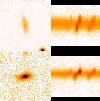Astro 103 - Lecture 22

 Lectures Lectures  |
Lecture page |
|

 Lectures Lectures  |
Lecture page |
|
 Planets' orbital speeds decrease with
orbital radius
Planets' orbital speeds decrease with
orbital radius
orbital speed  1/
1/
What we observe: rotation curves 
 (orbital radius)3 / (orbital period)2
(orbital radius)3 / (orbital period)2
 distance3 / time2
distance3 / time2
 mass
mass  (orbital radius) x (speed)2
(orbital radius) x (speed)2i.e., mass interior to orbital radius
 )
)

. . . not in cold or hot gas
. . . not in dust
 There must be dark halos!
There must be dark halos!
What makes up dark matter?
cooled white dwarfs ?
cooled neutron stars?
black holes?
``Shadow'' matter
- last refuge of scoundrels (theorists)
 90% of matter in the Universe doesn't shine!
90% of matter in the Universe doesn't shine!
How do we detect it?
 Glancing blows
Glancing blows
 Mergers
Mergers
Computer simulations:
- pure gravitational interactions
What's missing? (dust, gas ... the sticky stuff)
Recent models include this too!
Tidal tails
``like a hose'' ? .... not quite
If gas is included: invariably a nuclear starburst.
One plausible way to transform galaxies along the Hubble
Sequence:
. . . shake well and stir . . .
 giant elliptical
giant elliptical
Only found at the centers of galaxy clusters.
Why?
(b) there is substantial mass at large galactic radii
(c) all mass is contained within an interior radius
(d) there is little or no mass at large radii
(e) all mass is contained outside an interior radius
(b) groups
(c) pairs
(d) isolated in space
(e) isolated in space and in pairs
 Lectures Lectures  |
Lecture page |
|